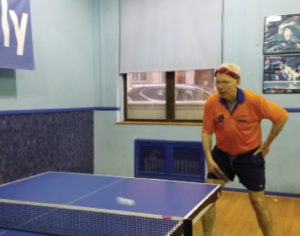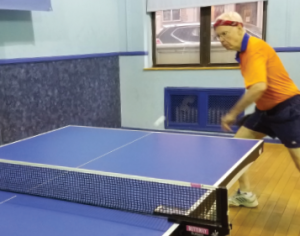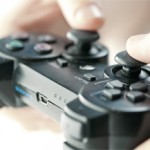 Roughly 15 years ago, Steven K. Magid, MD, rheumatologist and chief medical information officer at the Hospital for Special Surgery (HSS) in N.Y., attended a social event for hospital employees. While chatting with other physicians, nurses, and lab techs, he watched one of his colleagues slaughter her opponents at Ping-Pong.
Roughly 15 years ago, Steven K. Magid, MD, rheumatologist and chief medical information officer at the Hospital for Special Surgery (HSS) in N.Y., attended a social event for hospital employees. While chatting with other physicians, nurses, and lab techs, he watched one of his colleagues slaughter her opponents at Ping-Pong.
“She was very skilled,” recalls Dr. Magid, who also serves as the co-chair of the Quality Coordinating Committee and runs the Quality Research Center at HSS. “She had this really fancy blade [paddle] and creamed everybody she played against.”
That scenario partially changed Dr. Magid’s life, converting him into a Ping-Pong fanatic. Although he rarely competes, he trains with a coach twice each week and travels to other countries to either play the sport or watch competitions. He loves everything about the game—specifically its strategy and speed—and says it’s a cross between playing chess and car racing at the same time.
“It’s a very fast game and there is instant gratification or pain when you either make or miss a shot,” says Dr. Magid. “More happens in a few minutes of Ping-Pong than in an hour of football. The pace of the game, the strategy, is phenomenal.”
Yes, It’s Really a Sport

Dr. Magid wields his blade with practiced skill.
After graduating medical school at Cornell University in 1976, now called Weill Cornell Medicine, Dr. Magid completed his residency three years later at New York Hospital, which has since changed its name to New York–Presbyterian Hospital. Then he completed his fellowship at HSS in 1981.
It wasn’t until 20 years later that he was struck with Ping-Pong fever. Whether it was learning how to serve killer spins that appealed to him or meeting people from all over the world involved with the sport, he quickly became a devoted fan.
There’s a lot more to the game than what most people realize, he says, explaining that because he mostly trains with the same coach rather than competing against numerous players, it’s hard for him to read an opponent’s serve.
“The trick is not to show your opponent where on the table you’re going to serve or which of the myriad of spins you’re going to use on the ball,” says Dr. Magid, adding that each table is divided into nine quadrants. “It’s done by subterfuge, with motions before and after you strike the ball. You make it seem like you’re going to hit under the ball, but then instantly change your serve and hit a top spin.”
Just like fastball pitches in baseball, balls can also fly 100 MPH in professional Ping-Pong, which is not exactly the same speed traveled when people play Ping-Pong in their basement.
He also dispels myths that Ping-Pong isn’t a sport because players don’t need to be in great shape.
“Twice a week, I drench two or three shirts and am out of breath from the moment I start playing until the moment I stop,” he says. “You move back and forth probably faster than you ever have. Ping-Pong is very aerobic.”
Dr. Magid has trained in China and Korea, and played in Paris and Amsterdam, as well as with the Olympic team in Iceland during vacations to these locations. Still, after winning his first trophy in a tournament in New York more than a decade ago, he stopped competing. Because his time is so valuable, he says he’d rather play while training than compete. At most tournaments, he says, a lot of time is wasted between games while people wait to compete.
Back home, he trains at one of the several Ping-Pong clubs in New York City. Although the sport hasn’t caught fire in the U.S. like it has in Asian and European countries, he believes that can change. He points to recent publicity generated for the game by American moguls and players Bill Gates and Warren Buffet.
Almost anyone can play—rich or poor. The sport has a low barrier to entry.
“I’ve met so many different kinds of people from all walks of life,” he says, pointing to his partial collection of friends who play Ping-Pong—a Holocaust survivor, a 2008 Ping-Pong Olympian and a Lebanese computer entrepreneur.
“It’s a blessing to belong to a community composed of people from all over the world, with different beliefs and languages,” says Dr. Magid. “I think it makes me a better person, a better doctor.”
Powers of Observation
Besides the game’s fun side, Ping-Pong has also helped Dr. Magid strengthen his physician skills by sharpening his observation skills and ability to focus and concentrate.
“At Cornell, they teach art to medical students,” he says explaining that students learn to observe a painting’s subtle clues to understand the story created by the artist. “In any profession, focus is important. With Ping-Pong, you have to drown out every extraneous thought or noise in the room and focus on the serve, the ball, and how you’re going to position yourself.”
Unlike some other sports, Ping-Pong players don’t experience broken bones or concussions. He knows several octogenarians who regularly play and excel. They’ve been playing for so long that they know exactly where the ball is going to land and are ready for it.
“As long as I’m alive, I’m playing,” says Dr. Magid.
Carol Patton is a freelance writer based in Las Vegas.
Editor’s note: Listen to Dr. Magid talk about Ping-Pong .
Ping-Pong Diplomacy
The sport is also credited for opening up diplomatic relations between China and the U.S. One of Dr. Magid’s coaches served on the American Ping-Pong team and traveled with his teammates to China with President Nixon during the era of Ping‑Pong diplomacy. In 1971, the team was invited by its Chinese competitors to visit the People’s Republic for the World Table Tennis Championship.


